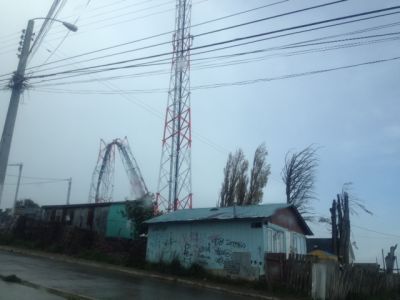Penetration in paragliders
I know it's Thanksgiving Day but this sounds like an April Fools post. I just found a report that the day before Jim Harris had his accident in Punta Arenas, Chile, on November 24, winds were gusting to 90 kph (56 mph) in Punta Arenas. On the day of his accident, winds were so strong - measured at 108 kph (67 mph) - they knocked down a cell tower. Here's the photo:

Harris is a writer and photographer whose work has appeared in National Geographic, Powder, Backpacker, Men's Journal and other publications. He has photographed wilderness outings in Mongolia, Bolivia and Antarctica among other places.
"He's a mountaineer, skier, photographer, writer," his younger brother Kyle Harris told ABC4 News.
He said Jim was practicing with his kite a few days before the expedition was to start.
"A big gust of wind came, lifted him up pretty high in the sky," Kyle said. "His emergency release did not release when he pulled it so he was dragged by his kite, slammed on the ground...He's got four broken vertebrae...The two in his lower back, the thoracic area are totally smashed."
The estimated cost of flying a specially equipped plane to bring him back to the U.S. is $300,000 and his total medical bills will be much more.
http://www.good4utah.com/story/d/story/ ... NTqU62pyCQDuring my flying career, when hang glider pilots started breaking 100 miles from the Owens Valley at the end of the 1970s to the late 1980s, I launched hang gliders many times in what turned out to be sheltered areas where it seemed okay, only to encounter high winds as my flight progressed. Yeah, I was a little too bold in my younger years and I'm lucky to be alive. I've also made many long cross-country flights in excess of a hundred miles where I've passed over violent gust fronts while flying at altitude in smooth air. I've flown around an overdeveloped thunderstorm dumping a huge vertical column of rain that created a furious gust front ring of dust a mile in diameter when it hit the ground. And I've lost altitude and landed in winds so strong I had to push out and hop over power lines while being driven backwards in turblent 40-55 mph winds at the surface. Landings in those conditions were terrifying. I've had to essentially fly into the ground at full bar in double surface ships flying backwards, dig the toes of my boots into the dirt, release the control bar and grab for the flying wires at the noseplate, hoping the glider wouldn't flip over backwards. I've been stuck in that position, crouched forward as far as I could go, French connection full forward, flying the glider on the ground and unable to drop the nose or reach back and to unhook, with the glider sliding backwards, sticking, sliding backwards again, for several tense minutes, watching my reinforced leading edges bow down, creaking, parts of the sail fluttering like machine guns, hoping for a lull.
On other occasions, I've suddenly become aware I was on my back, laying on top of the undersurface, looking up at the sky with no memory at all of what happened. No crash. No damage. No injuries. Yes, I was landing in turbulence just a moment before but not particularly concerned, when I guess a sudden gust must have flipped me over too quickly for it to register in my memory. That was Owens valley and some extreme examples from a pilot who made hundreds of flights there. But it is also planet Earth, and I know beyond a shadow of a doubt that people who fly low-penetration parachutes -- paragliders -- are "bringing a knives to gunfights."
You will need penetration to survive flying on this world. The atmosphere is very dynamic. It changes all the time. Conditions change all the time. It's like my old friend Klaus Kohmstedt told me on Gunter in 1981, "It's not the takeoff that worries me. I can control everything there. It's the landing..."
If you dare to fly Big Air, it is inevitable that someday you will launch in reasonable conditions and find, when you are at altitude, locked in and committed to ten or twenty minutes of descent before you can reach the ground, those conditions will change and wind and turbulence will challenge your survival. That day is coming for you and you must be prepared for it when it arrives. Flying the Owens, every few thermal turns I would scan the valley floor to the south for signs of rising dust. Rising dust meant LAND NOW. I gave up a lot of good flights out of caution. That was easy. Other times, I would look down from a couple miles to see dust storms suddenly spring up, raging below me, tearing across the desert like fingers of a giant hand. Dust storms below meant STAY HIGH and leave this deadly place. But sometimes that didn't work. That was hard.
It is hard, when you run out of options on a hang glider. But if you are foolish enough to choose a parachute as your aircraft, then may God help you because you will be unable to help yourself when the time comes that you need penetration to survive. Nor will you have smooth air at landing. You will need a robust airframe, a defined airfoil and a lot of skill to land safely. Otherwise you risk joining the 1,284 people I know of who have died on paragliders.
Paraglider pilots seem too full of themselves to understand the fickle nature of the atmosphere. If they would listen, I don't think we'd be seeing this endless series of deaths, paraplegia and quadraplegia.
Here is the fund-raising site for Jim Harris.
http://www.youcaring.com/medical-fundra ... ome/269288 Those were particularly funny!!
Those were particularly funny!! Those were particularly funny!!
Those were particularly funny!!









